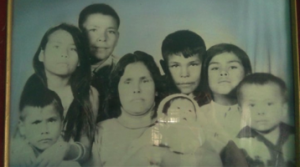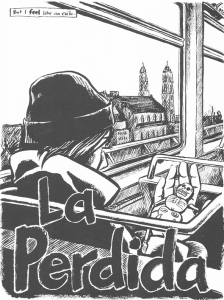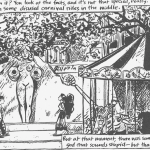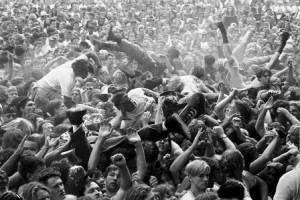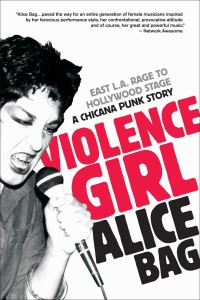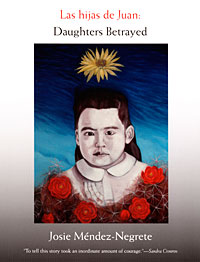On the 20th of October, Alice Bag tweeted, “Con dinero y sin dinero, hago siempre lo que quiero.” The lyrics, which translate to: “With money and without money, I always do what I want,” are the chorus from the song “El Rey” by José Alfredo Jiménez, a popular Mexican ranchera singer. The quote is followed by a link to a video of Alice performing the song live, but with her own twist. I found this fascinating because the very same song had significance to Josie Mendez-Negrete, whose book “Las Hijas de Juan,” also depicts a childhood of violence and abuse. However, both women seem to be taking different sides on the song’s meaning, and their interpretations demonstrate their responses to the culture of violence they grew up in.
In the section titled “El rey del machismo,” of Mendez-Negrete’s “Las Hijas de Juan,” Josie describes hearing “El Rey when visiting relatives in Wastonville:
I cried when I heard that song. My father was the song.
With money and without money
I do what I damn well please
And my word is the law
I have no throne and no queen
And no one to understand me
Pero sigo siendo el rey. 83
The song was very popular at the time but the young Josie related to the words in a very real, dark way. During her talk in our class, she prefaced her reading of this section of the book by apologizing; “I’m going to ruin this song for you.” Josie heard the song and heard the mantra of her own father, a man who could and would always do whatever he wanted to, and there was nothing that Josie, her mother, or her siblings could do about it. “He thought of himself as the owner of his wife and his daughters, to do with what he wanted,” she writes about her father (83). This attitude was protected by the patriarchal society that Mendez-Negrete grew up in-both in Mexico and the U.S. Society gave men the dominance and turned a blind eye to what was considered “acceptable” ways for a man to deal with his own family. This blind tolerance is the culture of violence that Josie grew up in, and was many years before someone decided to challenge the norm to step in and do something. To Josie, the song “El Rey” embodies the machismo, patriarchal, and abusive nature of her father, who was accepted and even loved as a member of society. Her response to this song was to cry, symbolic of the hurt and damage that her childhood imprisoned within the culture of violence did to her soul. She hates the song, and once she was freed of the psychotic abuse of her father, she lived her life as a pacifist, a teacher, and a social activist. She responded to the culture of violence by rejecting it, criticizing it, and working to prevent the further infliction of the same cruelty to other helpless women. Alice Bag on the other hand, as seen in her live performance of “El Rey,” immersed herself into her own interpretation of the culture of violence.
Alice also grew up witnessing incredible domestic abuse inflicted on her mother by her father. While she was not abused as much herself, she was just as suffocated in a prison of abuse at far too young of an age, as Mendez-Negrete was. They both had to grow up, witnessing and knowing things that no child should have to. They were both helpless to do anything about it. They were both stuck because the father was the sole supporter of the family, and the mother refused to leave the situation because she had no other options. The difference in the experiences of these two women lies in how they responded to the culture of violence. Once she was able to escape, Josie aimed to leave the violence behind and work for a better life for herself and others with similar experiences. When Alice was able to escape, she became anger and rage personified, using all her built-up hurt and frustration from her childhood into her own violent personality and punk persona. She embodied what was normally only acceptable for men. She expressed her inner turmoil through her onstage performances, which became famous for their frenzy, and often, bloodiness. She also retaliated by getting into fights frequently, sometimes encouraged by alcohol, but always by her refusal to be a victim: “The rage and aggression that were released onstage were like a leaky faucet that I couldn’t completely turn off when the performance was over. Without my being aware of it, the pent up feelings of anger were constantly dripping and starting to overflow into other areas of my life” (235). Because she was never able to stop the abuse she witnessed as a child, once she was able to be violent herself, she used it as a release. She also used it as a defense mechanism; she was always ready to attack if men harassed her at night, and she broke up with her boyfriend Nickey Beat because he slapped her. Alice describes her thoughts after Nickey hit her: “Many years before, I had vowed to myself that I would never be like my mother. I would never allow myself to be victimized… ‘You are either a tyrant or a victim…’ little Alicia whispers to me in the darkness. ‘…and you will never be a victim.’ (219)” Alice only saw one alternative to being a victim, and that was by being a tyrant, onstage and off. At one point she came to the realization that her rage was getting the best of her, and eventually calmed her violent punk lifestyle for that of a teacher. Although she is no longer behaving like a “monster,” (238), she still personifies a refusal to sustain the patriarchal culture of violence. Her performance of the song “El Rey” demonstrates that she took on the role of tyrant, abuser, MAN, and that she too, can do whatever she wants. By performing it in her own musical and performance style, she is reclaiming the song for women, for the abused, the victimized. To Alice Bag, the song is not something to cry about, not something to fear, but rather something to grab, with microphone in hand, and make it your own with a proud, defiant, smirk.
[youtube http://www.youtube.com/watch?v=HtD5qv9JxAA&w=560&h=315]


